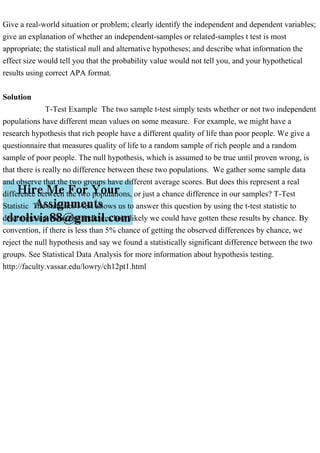Give a real-world situation or problem; clearly identify the indepen.pdf
Give a real-world situation or problem; clearly identify the independent and dependent variables; give an explanation of whether an independent-samples or related-samples t test is most appropriate; the statistical null and alternative hypotheses; and describe what information the effect size would tell you that the probability value would not tell you, and your hypothetical results using correct APA format. Solution T-Test Example The two sample t-test simply tests whether or not two independent populations have different mean values on some measure. For example, we might have a research hypothesis that rich people have a different quality of life than poor people. We give a questionnaire that measures quality of life to a random sample of rich people and a random sample of poor people. The null hypothesis, which is assumed to be true until proven wrong, is that there is really no difference between these two populations. We gather some sample data and observe that the two groups have different average scores. But does this represent a real difference between the two populations, or just a chance difference in our samples? T-Test Statistic The statistics t-test allows us to answer this question by using the t-test statistic to determine a p-value that indicates how likely we could have gotten these results by chance. By convention, if there is less than 5% chance of getting the observed differences by chance, we reject the null hypothesis and say we found a statistically significant difference between the two groups. See Statistical Data Analysis for more information about hypothesis testing. http://faculty.vassar.edu/lowry/ch12pt1.html.

Recommended
Recommended
More Related Content
Similar to Give a real-world situation or problem; clearly identify the indepen.pdf
Similar to Give a real-world situation or problem; clearly identify the indepen.pdf (20)
More from ammanelectronic
More from ammanelectronic (20)
Recently uploaded
Recently uploaded (20)
Give a real-world situation or problem; clearly identify the indepen.pdf
- 1. Give a real-world situation or problem; clearly identify the independent and dependent variables; give an explanation of whether an independent-samples or related-samples t test is most appropriate; the statistical null and alternative hypotheses; and describe what information the effect size would tell you that the probability value would not tell you, and your hypothetical results using correct APA format. Solution T-Test Example The two sample t-test simply tests whether or not two independent populations have different mean values on some measure. For example, we might have a research hypothesis that rich people have a different quality of life than poor people. We give a questionnaire that measures quality of life to a random sample of rich people and a random sample of poor people. The null hypothesis, which is assumed to be true until proven wrong, is that there is really no difference between these two populations. We gather some sample data and observe that the two groups have different average scores. But does this represent a real difference between the two populations, or just a chance difference in our samples? T-Test Statistic The statistics t-test allows us to answer this question by using the t-test statistic to determine a p-value that indicates how likely we could have gotten these results by chance. By convention, if there is less than 5% chance of getting the observed differences by chance, we reject the null hypothesis and say we found a statistically significant difference between the two groups. See Statistical Data Analysis for more information about hypothesis testing. http://faculty.vassar.edu/lowry/ch12pt1.html